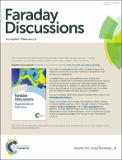Files in this item
A perspective on liquid salts for energy and materials
Item metadata
| dc.contributor.author | Irvine, John Thomas Sirr | |
| dc.date.accessioned | 2017-07-26T23:33:51Z | |
| dc.date.available | 2017-07-26T23:33:51Z | |
| dc.date.issued | 2016-08-01 | |
| dc.identifier | 244719077 | |
| dc.identifier | dd166ce2-1ea5-4d7a-9ebe-ad365601a111 | |
| dc.identifier | 84982151765 | |
| dc.identifier | 000381495600032 | |
| dc.identifier.citation | Irvine , J T S 2016 , ' A perspective on liquid salts for energy and materials ' , Faraday Discussions , vol. 190 , pp. 551-559 . https://doi.org/10.1039/C6FD00173D | en |
| dc.identifier.issn | 1359-6640 | |
| dc.identifier.other | ORCID: /0000-0002-8394-3359/work/68280603 | |
| dc.identifier.uri | https://hdl.handle.net/10023/11301 | |
| dc.description | The author thanks EPSRC for platform support, EP/K015540/1 and the Royal Society for a Wolfson Merit Award WRMA 2012/R2. | en |
| dc.description.abstract | Liquid salts comprising molten salts and ionic liquids offer important media to address both energy and materials challenges. Here we review topics presented in the current Faraday Discussion volume related to improved electrowinning of metals, optimisation of processes, new electrochemical device concepts, chemistry in ionic liquids, conversion of biomass, carbon chemistry and nuclear applications. The underlying phenomenology is then reviewed and commentary given. Some future applications are then discussed, further exemplifying the high potential rewards achievable from these chemistries. | |
| dc.format.extent | 9 | |
| dc.format.extent | 940949 | |
| dc.language.iso | eng | |
| dc.relation.ispartof | Faraday Discussions | en |
| dc.subject | QD Chemistry | en |
| dc.subject | T-NDAS | en |
| dc.subject.lcc | QD | en |
| dc.title | A perspective on liquid salts for energy and materials | en |
| dc.type | Journal article | en |
| dc.contributor.sponsor | EPSRC | en |
| dc.contributor.sponsor | The Royal Society | en |
| dc.contributor.institution | University of St Andrews. School of Chemistry | en |
| dc.contributor.institution | University of St Andrews. EaSTCHEM | en |
| dc.identifier.doi | 10.1039/C6FD00173D | |
| dc.description.status | Peer reviewed | en |
| dc.date.embargoedUntil | 2017-07-26 | |
| dc.identifier.grantnumber | EP/K015540/1 | en |
| dc.identifier.grantnumber | WRMA 2012/R2 | en |
This item appears in the following Collection(s)
Items in the St Andrews Research Repository are protected by copyright, with all rights reserved, unless otherwise indicated.

